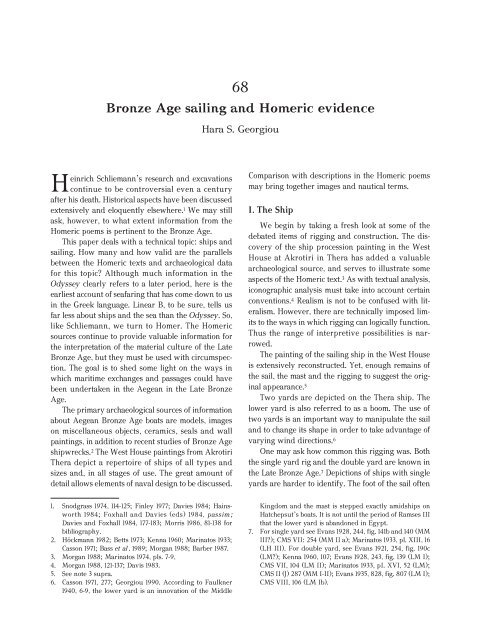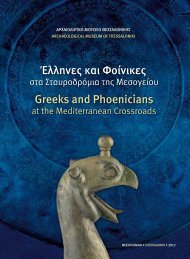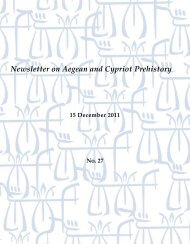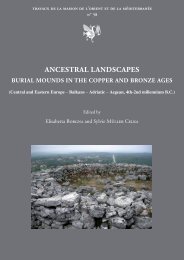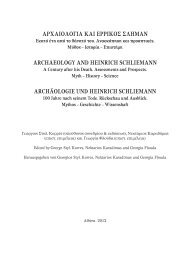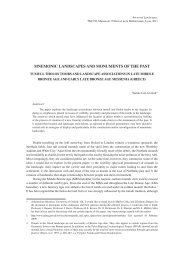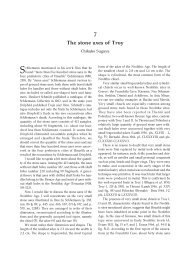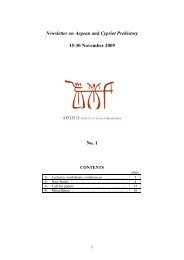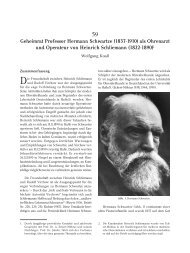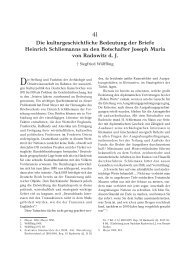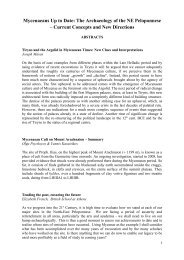You also want an ePaper? Increase the reach of your titles
YUMPU automatically turns print PDFs into web optimized ePapers that Google loves.
68<br />
<strong>Bronze</strong> <strong>Age</strong> <strong>sailing</strong> <strong>and</strong> <strong>Homeric</strong> <strong>evidence</strong><br />
Hara S. Georgiou<br />
Heinrich Schliemann’s research <strong>and</strong> excavations<br />
continue to be controversial even a century<br />
after his death. Historical aspects have been discussed<br />
extensively <strong>and</strong> eloquently elsewhere. 1 We may still<br />
ask, however, to what extent information from the<br />
<strong>Homeric</strong> poems is pertinent to the <strong>Bronze</strong> <strong>Age</strong>.<br />
This paper deals with a technical topic: ships <strong>and</strong><br />
<strong>sailing</strong>. How many <strong>and</strong> how valid are the parallels<br />
between the <strong>Homeric</strong> texts <strong>and</strong> archaeological data<br />
for this topic? Although much information in the<br />
Odyssey clearly refers to a later period, here is the<br />
earliest account of seafaring that has come down to us<br />
in the Greek language. Linear B, to be sure, tells us<br />
far less about ships <strong>and</strong> the sea than the Odyssey. So,<br />
like Schliemann, we turn to Homer. The <strong>Homeric</strong><br />
sources continue to provide valuable information for<br />
the interpretation of the material culture of the Late<br />
<strong>Bronze</strong> <strong>Age</strong>, but they must be used with circumspection.<br />
The goal is to shed some light on the ways in<br />
which maritime exchanges <strong>and</strong> passages could have<br />
been undertaken in the Aegean in the Late <strong>Bronze</strong><br />
<strong>Age</strong>.<br />
The primary archaeological sources of information<br />
about Aegean <strong>Bronze</strong> <strong>Age</strong> boats are models, images<br />
on miscellaneous objects, ceramics, seals <strong>and</strong> wall<br />
paintings, in addition to recent studies of <strong>Bronze</strong> <strong>Age</strong><br />
shipwrecks. 2 The West House paintings from Akrotiri<br />
Thera depict a repertoire of ships of all types <strong>and</strong><br />
sizes <strong>and</strong>, in all stages of use. The great amount of<br />
detail allows elements of naval design to be discussed.<br />
Comparison with descriptions in the <strong>Homeric</strong> poems<br />
may bring together images <strong>and</strong> nautical terms.<br />
I. The Ship<br />
We begin by taking a fresh look at some of the<br />
debated items of rigging <strong>and</strong> construction. The discovery<br />
of the ship procession painting in the West<br />
House at Akrotiri in Thera has added a valuable<br />
archaeological source, <strong>and</strong> serves to illustrate some<br />
aspects of the <strong>Homeric</strong> text. 3 As with textual analysis,<br />
iconographic analysis must take into account certain<br />
conventions. 4 Realism is not to be confused with literalism.<br />
However, there are technically imposed limits<br />
to the ways in which rigging can logically function.<br />
Thus the range of interpretive possibilities is narrowed.<br />
The painting of the <strong>sailing</strong> ship in the West House<br />
is extensively reconstructed. Yet, enough remains of<br />
the sail, the mast <strong>and</strong> the rigging to suggest the original<br />
appearance. 5<br />
Two yards are depicted on the Thera ship. The<br />
lower yard is also referred to as a boom. The use of<br />
two yards is an important way to manipulate the sail<br />
<strong>and</strong> to change its shape in order to take advantage of<br />
varying wind directions. 6<br />
One may ask how common this rigging was. Both<br />
the single yard rig <strong>and</strong> the double yard are known in<br />
the Late <strong>Bronze</strong> <strong>Age</strong>. 7 Depictions of ships with single<br />
yards are harder to identify. The foot of the sail often<br />
1. Snodgrass 1974, 114-125; Finley 1977; Davies 1984; Hainsworth<br />
1984; Foxhall <strong>and</strong> Davies (eds) 1984, passim;<br />
Davies <strong>and</strong> Foxhall 1984, 177-183; Morris 1986, 81-138 for<br />
bibliography.<br />
2. Höckmann 1982; Betts 1973; Kenna 1960; Marinatos 1933;<br />
Casson 1971; Bass et al. 1989; Morgan 1988; Barber 1987.<br />
3. Morgan 1988; Marinatos 1974, pls. 7-9,<br />
4. Morgan 1988, 121-137; Davis 1983.<br />
5. See note 3 supra.<br />
6. Casson 1971, 277; Georgiou 1990. According to Faulkner<br />
1940, 6-9, the lower yard is an innovation of the Middle<br />
Kingdom <strong>and</strong> the mast is stepped exactly amidships on<br />
Hatchepsut’s boats. It is not until the period of Ramses III<br />
that the lower yard is ab<strong>and</strong>oned in Egypt.<br />
7. For single yard see Evans 1928, 244, fig. 141b <strong>and</strong> 140 (MM<br />
III?); CMS VII: 254 (MM II a); Marinatos 1933, pl. XIII, 16<br />
(LH III). For double yard, see Evans 1921, 254, fig. 190c<br />
(LM?); Kenna 1960, 107; Evans 1928, 243, fig. 139 (LM I);<br />
CMS VII, 104 (LM II); Marinatos 1933, pI. XVI, 52 (LM);<br />
CMS II (J) 287 (MM I-II); Evans 1935, 828, fig. 807 (LM I);<br />
CMS VIII, 106 (LM Ib).
524 Hara S. Georgiou<br />
terminates directly on or behind the gunwale <strong>and</strong> is<br />
thus not differentiated.<br />
Ships with two yards occur in Minoan glyptic as<br />
early as the MM II period. 8 In the case of rigging with<br />
two yards, the archaeological <strong>and</strong> textual sources differ<br />
from each other. There is no reference to this system<br />
in Homer. A single yard is described. 9 The single<br />
yard is preferred during <strong>and</strong> subsequent to the <strong>Bronze</strong><br />
<strong>Age</strong>.<br />
Some observations about the <strong>sailing</strong> ship are possible<br />
despite the lacunae in the painting. 10 The lines<br />
are insufficient to h<strong>and</strong>le the rigging needed for a<br />
<strong>sailing</strong> ship with two yards. At least this aspect of the<br />
painting is representative rather than literal. 11 Anywhere<br />
from two to seven or eight lines are seen on<br />
various examples in glyptic <strong>and</strong> on other ships of the<br />
Thera painting. Five loops for sheets to pass through<br />
are reconstructed on either side of the mast above the<br />
yard. This is based on the rigging of two other masted<br />
ships in the same painting. Thus, up to ten lines<br />
can be accommodated on this type of mast. On the<br />
<strong>sailing</strong> ship, four halyards are clearly marked: two on<br />
either side of the mast. They are for hoisting the sail<br />
on the yards.<br />
We will now compare the painting <strong>and</strong> rigging<br />
described in Homer. The rigging or any part of it is<br />
referred to as ¬πλων. 12 The use of two headstays is<br />
mentioned in the Odyssey. 13 The backstay is the heaviest<br />
line 14 <strong>and</strong> it is made of ox hide because it supports<br />
most of the weight of the rigging, especially in a<br />
square sail rig, <strong>and</strong> because it regulates the angle of<br />
the mast. 15 Ox hide halyards are also mentioned. 16<br />
Other lines are made of papyrus 17 <strong>and</strong> rushes. 18<br />
Braces control the upper yard <strong>and</strong> its lateral<br />
adjustment. 19 Sheets control the lower yard, or boom. 20<br />
Two topping lifts on either side connect the upper<br />
yard with the mast. 21 The mast is set 22 in the central<br />
thwart. 23 The sail is hoisted 24 <strong>and</strong> spread. 25 It is<br />
furled 26 or gathered 27 by lowering to the lower yard if<br />
there are two. To lower or let out the sail 28 one releases<br />
the back stay. The running rigging is lowered 29 into<br />
crutches. 30 All of these lines <strong>and</strong> functions can be seen<br />
on the <strong>sailing</strong> ship <strong>and</strong> the other ships in the painting.<br />
Permanent stays to hold the stepped mast are not<br />
depicted in the painting or mentioned in the <strong>Homeric</strong><br />
poems but may be shown on seals. Shrouds do not<br />
appear to have been used. The lack of st<strong>and</strong>ing rigging<br />
raises interesting questions about the way that<br />
ships traveled. Morgan believes that it shows that<br />
voyages (or the specific voyage in the Thera fresco)<br />
were of short duration. 31 I think that fore <strong>and</strong> aft stays<br />
were rigged at the same time as the mast <strong>and</strong> tightened<br />
before the sails were hoisted. Keeping any organic<br />
rope or cable under permanent pressure might<br />
weaken it or cause it to snap. For instance, Agamemnon’s<br />
rigging, which is made from rushes, is out of<br />
commission, presumably from lack of replacement<br />
<strong>and</strong> exposure. 32<br />
Many different types of boats are described in the<br />
Odyssey <strong>and</strong> depicted on the Thera painting. Clearly,<br />
the many oared light weight ships used for war or<br />
pirating expeditions cannot have had the same hull<br />
construction as merchant ships which required a<br />
completely different capacity. 33 Thus, all boats cannot<br />
be maneuvred or used in the same way.<br />
The boat described as having a hold large enough<br />
to contain several crew members 34 is different from<br />
the boat in which a person can fall from the deck into<br />
the bilges, 35 or the boat in which Odysseus binds his<br />
companions under the thwarts lacking space in the<br />
8. See note 6 supra.<br />
9. âπίκριον, Od. V.254 <strong>and</strong> elsewhere. Terms are transcribed<br />
directly from the text <strong>and</strong> will not necessarily be in the<br />
nominative or infinitive.<br />
10. Morgan 1988, 121-137 passim.<br />
11. Davis 1983.<br />
12. Od. II. 23, 426, XII. 410, XIV.346, XXI.390.<br />
13. προτόνοι, Od. II.425.<br />
14. âπίτονος, Od. XII.423.<br />
15. Od. V. 260.<br />
16. Od. XV. 291.<br />
17. βύβλινον, Od. XXI.391.<br />
18. σπάρτα, rushes Il. II.135.<br />
19. κάλους, Od. V.260.<br />
20. πόδας, Od. V.260.<br />
21. •πέρας, Od. V.260.<br />
22. îστόν ... στÉσαν àείραντες, Od. II.422-428.<br />
23. µεσόδµη, Od. II.424, VI.289, XV.289.<br />
24. àνa... âρύσαντες, Od. IX. 77; ≤λκον ¥στια, Od. XV.291.<br />
25. àνa πέτασσαν, Il. I. 480.<br />
26. îστία µηρύσαντο, Od. XII.170.<br />
27. îστία στείλαντο, Il. I.433; Od. III.10-11.<br />
28. λίον îστία, Od. XV.496.<br />
29. κάθεµεν, Od. IX.72, or καθείλοµεν, Od. IX.149.<br />
30. îστοδόκFη, Il. I.434; îστοπέδη, Od. XII.51.<br />
31. Morgan 1988, 126.<br />
32. Il. II.135.<br />
33. Bass et al. 1989, 1-29, fig. 2.<br />
34. âντeς, Od. XII.225.<br />
35. ôντλω δ’âνδούπησε, Od. XV.749; ôντλου also occurs in Od.<br />
XII.411.
<strong>Bronze</strong> <strong>Age</strong> <strong>sailing</strong> <strong>and</strong> <strong>Homeric</strong> <strong>evidence</strong> 525<br />
hold. 36 Thus, one should not expect to find all these<br />
features on one boat, nor should one expect the features<br />
to be the same size, even though they can have<br />
the same name. Some boats can have shallower, others<br />
deeper holds, depending on their purpose. Merchant<br />
ships needed to have a completely different construction<br />
in order to accommodate cargo <strong>and</strong> crew over<br />
long periods of time.<br />
The larger Theran boats are characterised by the<br />
following features: absence of keels; relatively shallow<br />
draft <strong>and</strong> low freeboard; small sail area; square<br />
sails; oars to compensate for lack of maneuvrability<br />
<strong>and</strong> for power when needed. 37 Two steering oars are<br />
depicted to starboard. One of these could have been<br />
moved to port. 38 Decks are depicted <strong>and</strong> canopies typically<br />
positioned aft. 39 Masted boats have long, narrow<br />
hulls with a curved bow <strong>and</strong> a mast set just forward<br />
of the center. The mast is stepped <strong>and</strong> set up<br />
through the main thwart. 40 The mast position on the<br />
Theran ships is an innovation. In depictions of Egyptian<br />
ships 41 <strong>and</strong> Minoan ships on seals, the masts are<br />
centered. Thus the placement of the mast at Thera is<br />
new <strong>and</strong> worthy of note. It has been changed deliberately<br />
in response to experimentation. 42<br />
A l<strong>and</strong>ing plank or ladder is referred to only once. 43<br />
It is made of polished wood <strong>and</strong> dragged astern. This<br />
problematical piece of equipment may be the controversial<br />
stern ornament figured in the Thera ships. 44<br />
This object is likely to have had another use besides<br />
being an aide for boarding. 45<br />
On the North wall in the depiction of the shipwreck,<br />
a man holding a long pole st<strong>and</strong>s in the bow<br />
of an oared boat near the shore. 46 The pole is held vertically<br />
<strong>and</strong> at arm’s length. The gesture does not suggest<br />
attacking. It may be a pole used as a boat hook or<br />
for punting. 47 Three other long poles are placed on<br />
the forward deck. Two different words are used in<br />
Homer for long poles in boating contexts. The κοντeς<br />
is used for shoving off. 48 The ξυστeν is a long pole<br />
tipped with bronze used for fighting in sea battles. 49<br />
II. Beaching, Mooring, Harbours<br />
The frequent references to the beaching of boats in<br />
the <strong>Homeric</strong> texts have led scholars to assume that<br />
this was a common practice for all types of boats. It is<br />
commonly thought that a smooth beach was the only<br />
installation needed <strong>and</strong> that all types of ships were<br />
regularly pulled up on to the beach for loading, unloading<br />
<strong>and</strong> protection from the weather. The boat<br />
that delivers Odysseus, presumably not heavily<br />
laden, is beached only for the amount of time it takes<br />
to disembark him. 50 But the custom of beaching light<br />
weight boats or skiffs can most certainly not be<br />
applied universally.<br />
War ships, favoured for speed, are relatively light<br />
<strong>and</strong> shallow <strong>and</strong> can be easily hauled on to l<strong>and</strong> <strong>and</strong><br />
propped. 51 Merchant ships with deep rounded hulls<br />
travelling with full loads of cargo were surely not<br />
beached. 52 Two good examples are the Cape Gelidonya<br />
53 <strong>and</strong> the Ulu Burun wrecks. 54 These vessels<br />
were so heavily laden that beaching would have<br />
resulted in serious damage to the hull, even if their<br />
weight permitted them to be hauled on to l<strong>and</strong> in the<br />
first place. Merchant vessels could only be beached<br />
when empty. Otherwise, they needed a decent an-<br />
36. •πe ζυγa, Od. IX.99.<br />
37. See Morgan 1988 for bibliography.<br />
38. Morgan 1988, 126.<br />
39. €κρια (¨κριόφιν), Od. XIII.74.<br />
40. µεσόδµη, Od. II.424.<br />
41. Faulkner 1940.<br />
42. Different angles to the wind can be achieved as well as<br />
more stability in <strong>sailing</strong> downwind. Although it is mostly<br />
reconstructed, the sail area on the <strong>sailing</strong> ship appears to<br />
be considerably smaller than that of contemporary Egyptian<br />
merchantmen, <strong>and</strong> the hull is probably proportionately<br />
shorter. Reduction of the sail area indicates a preference<br />
for greater maneuvrability over speed.<br />
43. âφόλκαιον, Od. XIV.350; ôφλαστον =stern ornament? Il.<br />
XV.717.<br />
44. Morgan 1988, 135.<br />
45. See Morgan 1988, 135-137 for a synopsis of the various<br />
opinions.<br />
46. Morgan (1988, 152) compares this to a scene from the<br />
Mycenae siege rhyton <strong>and</strong> a fragment from Epidauros.<br />
47. Similar poles are depicted on Egyptian paintings. These<br />
can be straight or hooked as in Newberry 1894, pl. 18.<br />
There is no mention in Homer of the use of a pole or any<br />
other instrument for making soundings.<br />
48. On departing from the Cyclops’ isl<strong>and</strong>, Od. IX.487-488.<br />
49. Il. XV.388, 677.<br />
50. Od. XIII.113-125.<br />
51. Warships carry few provisions (Od. II.354, 349, V.266,<br />
IX.165, IV.359) <strong>and</strong> availability of fresh water in harbours<br />
is important (Od. IX. 85, 140, X.56, XIII.109).<br />
52. The distinction between the two types of ships exists in<br />
Homer.<br />
53. Bass 1967.<br />
54. Bass 1987: 693-733. Hull length is approximately 50 feet.<br />
The cargo included several stone anchors <strong>and</strong> about six<br />
tons of copper. Bass et al. 1989.
526 Hara S. Georgiou<br />
chorage or mooring which would allow for safe loading<br />
<strong>and</strong> unloading. 55 A beach alone would not suffice.<br />
Amnissos has a good beach yet is considered a difficult<br />
harbour, probably because it has no protection<br />
from the North wind. 56 In the Odyssey, one of the best<br />
harbours is considered to be Vathy (Phorcys) in Ithaca<br />
described lovingly <strong>and</strong> in great detail with its multiple<br />
types of anchorages. 57<br />
III. Night Sailing<br />
Importance has been placed on the need to define<br />
routes by the measure of a day’s sail. But travelling<br />
time obviously depends on the weather <strong>and</strong> not on<br />
the skipper’s wishes. Although arrival before nightfall<br />
may be preferable, there is absolutely no guarantee<br />
that this will occur. A master or a pilot of a ship<br />
had to know the stars.<br />
In Homer, a method of computing time by the<br />
stars is used. Three night watches are mentioned <strong>and</strong><br />
a fourth is inferred. 58 The watches are timed by the<br />
sequence of a designated group of first <strong>and</strong> second<br />
magnitude stars near the ecliptic known as the decan<br />
stars or clock stars. They vary according to the season.<br />
Star time increases by four minutes each day. 59 Εach<br />
star or group rises heliacally with a difference of plus<br />
or minus ten days in relation to the adjacent group<br />
thus giving the name “decade” to the group <strong>and</strong><br />
“decan star” to the first star in each decade. 60 Every 40<br />
minutes one star in the sequence crosses the celestial<br />
north-south meridian line which divides the night sky<br />
into eastern <strong>and</strong> western halves. Each day the series<br />
of stars observed is diminished by one at sunset <strong>and</strong><br />
increased by one at dawn. A designated star’s zenith<br />
or meridian crossing was observed at midnight. The<br />
third watch is when the current decan star <strong>and</strong> those<br />
stars in front of it have all passed the meridian <strong>and</strong><br />
are descending.<br />
These simple navigational aids are also attested in<br />
other seagoing <strong>and</strong> preliterate cultures. 61 Unless ocean<br />
voyages are involved, the star clock would not pose<br />
too much of a problem in calculating time. Seventeen<br />
days is the longest recorded time in the <strong>Homeric</strong> texts<br />
for a passage without l<strong>and</strong>fal1. 62 The ability to underst<strong>and</strong><br />
<strong>and</strong> apply the decanal system suggests some<br />
measure of navigational sophistication.<br />
Indeed, the Odyssey is the earliest text in Greek to<br />
mention celestial navigation <strong>and</strong> provide information<br />
about night <strong>sailing</strong>. 63 The Dog Star is known. 64 The<br />
morning <strong>and</strong> evening stars marking the East <strong>and</strong> the<br />
West are mentioned but do not appear to be equated.<br />
65<br />
55. The war ships are relatively shallow <strong>and</strong> can be easily<br />
hauled on to l<strong>and</strong> <strong>and</strong> set on props, öχµατα, Il. I.486,<br />
II.154, <strong>and</strong> öρµατα, Il. XIV. 410. Rollers may be used to<br />
lower the craft of Odysseus to the water, Od. V.261. They<br />
are more common in later texts.<br />
56. Od. XIX.185-200.<br />
57. Od. XIII.96 ff. See also Shaw 1989 on suitable harbours.<br />
58. Od. XII.312, XIV.483; <strong>and</strong> especially Il. X.251-253<br />
although the passage is of problematical date.<br />
59. Cotter 1968, 36.<br />
60. Cotter 1968, 35-36. Leach 1954, 115, 123-124; Neugebauer<br />
1954, 796: In the Egyptian civil calendar the month consisted<br />
of three 10 day intervals or “decades” linked to heliacal<br />
risings of certain stars. The stars themselves were<br />
called “decans” by the Greeks. The consecutive risings of<br />
the decans were used at least as early as 2500 BC as a star<br />
clock to indicate the “hours of the night”. Approximately<br />
12 of these decans covered the interval of darkness<br />
between dusk <strong>and</strong> dawn. According to Neugebauer (1954,<br />
797 <strong>and</strong> 1957, 82-86) time reckoning by decans was later<br />
replaced by an improved method of observing transits of<br />
stars. On Middle Kingdom coffin lids the decanal constellations<br />
are arranged in 10 day intervals throughout the<br />
year forming 36 columns with 12 lines each for the 12<br />
hours of the night. The year has 360 days or 36 decans.<br />
The name of the specific decan moves up one line from column<br />
to column creating a diagonal pattern. This is a star<br />
clock. The “hour” of the night is determined by the rising<br />
of the decan which is listed in the proper decade of the<br />
month. The system was decimal for daylight, duodecimal<br />
for darkness. During or before the New Kingdom, decanal<br />
clocks were replaced by a system based on observing the<br />
culmination of stars for decans. Neugebauer 1957, 88-89<br />
(tombs of Senmut, Seti I, Ramses VI, VII, IX). It would<br />
appear that both systems are known in the <strong>Homeric</strong> texts,<br />
<strong>and</strong> both certainly predate the 8 th c. BC. See Leitz 1989 for<br />
the tomb of Senmut <strong>and</strong> more recent research on Egyptian<br />
astronomy.<br />
61. Thomas 1987, 73-115 for Micronesian navigation. It was also<br />
known to the Egyptians (Cotter 1968, 36). Orion, the<br />
Pleiades <strong>and</strong> Sirius are amongst the few decan stars which<br />
can be identified with any certainty (Leach 1954, 115;<br />
Neugebauer 1957, 83; Leitz 1989).<br />
62. Calypso’s isl<strong>and</strong> may belong to the realm or fantasy, but a<br />
trip of seventeen days duration is not inconceivable.<br />
63. For examples see Od. II.413 ff., II.434, III.1-5, III.177-178,<br />
V.33-35, V.269-282, IX.82, XII.279 ff., XIII.29ff., XIII.70-<br />
95, XV.296.<br />
64. Il. XXII.27-29, V.5, <strong>and</strong> possibly XI.62.<br />
65. Il. XXIII.226 <strong>and</strong> II. XXII.318 respectively.
<strong>Bronze</strong> <strong>Age</strong> <strong>sailing</strong> <strong>and</strong> <strong>Homeric</strong> <strong>evidence</strong> 527<br />
On leaving Calypso at night, Odysseus sets a<br />
course to the East by keeping Bootes (Arcturus) <strong>and</strong><br />
the Bear or Wain (Ursa Major) to his left for 17 days. 66<br />
Orion is described together with Ursa Major, a phenomenon<br />
of the winter sky. 67<br />
Thus, ancient Greek seafarers as described in<br />
Homer were surely prepared for night travel <strong>and</strong> that<br />
includes not only navigation by the stars but also the<br />
knowledge of harbours <strong>and</strong> the ability to find l<strong>and</strong>fall<br />
at night. They were evidently prepared to sail in winter,<br />
despite the advice of Hesiod who was an unadventurous<br />
<strong>and</strong> overly cautious soul <strong>and</strong> in any case<br />
not much of a sailor.<br />
IV. Professional sailors<br />
The <strong>Homeric</strong> <strong>evidence</strong> suggests that these sailors<br />
were well taught. Many authors have argued that a<br />
lack of a seamanship is shown in the <strong>Homeric</strong> descriptions.<br />
I believe that their abilities have been underestimated.<br />
Given the types of boats <strong>and</strong> the technology<br />
available at the time of Homer <strong>and</strong> earlier, it is quite<br />
logical that caution was essential. In fact, the fear <strong>and</strong><br />
caution about the seas vividly expressed in the Odyssey<br />
shows a great knowledge of the Aegean <strong>and</strong> respect<br />
for its unpredictability in all seasons. The fact<br />
that so many deities are attributed with control of the<br />
winds emphasises precisely this unpredictability of<br />
the weather. The Aegean is one of the most treacherous<br />
bodies of water in the world. Even today, sailors<br />
with experience of this sea are wary of such points as<br />
Cape Malea <strong>and</strong> Cavo Doro.<br />
Navigating was undoubtedly a specialised occupation.<br />
Professional sailors are mentioned in the<br />
Odyssey. 68 Traders are distinguished from pirates. 69<br />
In addition to Noëmon who lent Telemachus a boat, 70<br />
the Phaeacians figure prominently as a people whose<br />
existence is linked with the sea. 71<br />
Navigating may have been an inherited occupation.<br />
It requires not only experience in h<strong>and</strong>ling boats<br />
<strong>and</strong> rigging, but also knowledge of the seas, the l<strong>and</strong>marks<br />
<strong>and</strong> the skies both by day <strong>and</strong> night which can<br />
only be acquired gradually through experience to be<br />
effective, <strong>and</strong> is likely to have been learned over more<br />
than one generation by word of mouth as well as by<br />
practice. Lest we forget, Odysseus is the son of an<br />
Argonaut.<br />
The isl<strong>and</strong> <strong>and</strong> coastal populations of the Aegean,<br />
the pirates, the raiders <strong>and</strong> the traders were surely<br />
the most innovative <strong>and</strong> experimental boat designers.<br />
Ship building as a skill or as a profession is linked<br />
with mastery in the use of ships: although an experienced<br />
sailor may not necessarily become a ship<br />
builder, the reverse is inconceivable. In Linear B, ship<br />
building is a specialised occupation. 72 There are references<br />
to this craft in the <strong>Homeric</strong> texts. 73 The<br />
description of the raft of Odysseus includes many<br />
details about shipbuilding methods <strong>and</strong> materials. 74<br />
V. Conclusions<br />
Today there are more images from the <strong>Bronze</strong> <strong>Age</strong><br />
<strong>and</strong> the early Iron <strong>Age</strong> to supplement words <strong>and</strong> descriptions.<br />
Our vision of material culture has been significantly<br />
enriched in the last twenty years. Yet the<br />
marriage of word with image to evoke an object must<br />
continue to be approached with caution. More surprises<br />
may await us on the unexcavated walls of<br />
Akrotiri.<br />
In conclusion, many of the nautical terms in the<br />
Odyssey <strong>and</strong> the Iliad have been made more vivid by<br />
the Thera depictions. There are more coincidences<br />
66. Od. V.269-282.<br />
67. On the shield of Achilles, Il. XVIII. 486-489 <strong>and</strong> Od.<br />
V.271-275. The Pleiades are mentioned in both passages.<br />
The Pleiades <strong>and</strong> the Hyades in Taurus <strong>and</strong> Arcturus in<br />
Bootes differ nearly eleven hours in night ascension,<br />
occurring together (as in Od. V) in the winter months. The<br />
Pleiades or Arcturus would be visible at all times of the<br />
year although Arcturus is dominant in the summer. At the<br />
latitude of the Aegean, these constellations are in the<br />
northern quarter <strong>and</strong> circle around the pole. When the<br />
“Bear watches Orion”, Orion is in the southern quarter.<br />
The <strong>Homeric</strong> texts indicate knowledge of seasonal changes<br />
in the night sky. These simple observations are essential to<br />
celestial navigation. The Bear is no longer a non-setting<br />
circumpolar constellation in the Mediterranean <strong>and</strong> the<br />
nearest star to the pole was probably Kochab, a second<br />
magnitude star in Ursa Minor which was not identified as<br />
a constellation until a later date.<br />
68. êλιεÜσι, Od. XXIV.419; πορθµÉες, Od. XX.187; ναÜται,<br />
Od. XV.435.<br />
69. For traders, see Od. I.184, XIV.452, XV.415. For piracy,<br />
see Il. IX.138-140, 278-282, XVIII.326-7; Od. IX.39-42,<br />
XIV.229-234, XV.427 <strong>and</strong> 449-453, XVI.426-430.<br />
70. Od. IV.634.<br />
71. Od. VIII.557.<br />
72. na-u-do-mo, PY 189. Ventris <strong>and</strong> Chadwick 1973.<br />
73. Il. V.59-63, XV.410-412.<br />
74. Od. V. passim for the building of the raft, V. 269-282; IX.<br />
384.
528 Hara S. Georgiou<br />
than differences. The nautical terms themselves are<br />
etymologically evocative. It would seem that much of<br />
the naval technology of the Odyssey can be applied to<br />
boats of the Late <strong>Bronze</strong> <strong>Age</strong> such as those in the<br />
Thera painting <strong>and</strong> the excavated wrecks. Certainly,<br />
we do not find in the texts items that appear to be any<br />
more sophisticated technically than those shown in<br />
Late <strong>Bronze</strong> <strong>Age</strong> depictions. The navigational systems<br />
<strong>and</strong> the knowledge of astronomy attested in the<br />
<strong>Homeric</strong> texts are based on Egyptian systems of the<br />
Middle <strong>and</strong> Late <strong>Bronze</strong> <strong>Age</strong>. The introduction of this<br />
knowledge into the Aegean area can most certainly<br />
have occurred before the 8 th c. BC.<br />
The ships of the Late <strong>Bronze</strong> <strong>Age</strong> may have differed<br />
in some respects from those of Homer’s day<br />
(8 th c. BC or later), but the tradition of the sea <strong>and</strong><br />
navigational knowledge is not likely to have changed<br />
much. Moreover, whether two yards or one, we are<br />
dealing with a square sail that will have determined<br />
how close hauled the ship could sail.<br />
Construction <strong>and</strong> the rigging determine the h<strong>and</strong>ling<br />
<strong>and</strong> function of a boat. By comparing the routes<br />
<strong>and</strong> <strong>sailing</strong> practices described in the Odyssey to theoretical<br />
routes based on artifact distribution we can<br />
begin to reconstruct ways in which sea communication<br />
was undertaken. The similarity of artifacts at a<br />
number of sites will not by itself, however, give an<br />
accurate picture of the routes followed or the harbours<br />
used. The type of ship, the effects of the wind,<br />
currents, <strong>and</strong> geography, all must be taken into consideration.<br />
75<br />
Geomorphological studies at present under way<br />
may well alter our picture of a good many coastlines.<br />
76 A reevaluation of some approaches by sail<br />
may be required if it is shown that a different coastline<br />
might have caused changes in local winds or currents.<br />
Yet the prevailing winds <strong>and</strong> wind systems, as<br />
well as the preferred routes <strong>and</strong> approaches to l<strong>and</strong><br />
will have been much as they are for the modem sailor.<br />
In this sense, Homer’s descriptions of seas, winds,<br />
<strong>and</strong> routes are valid even today, <strong>and</strong> both Homer <strong>and</strong><br />
the modern sailor’s experience can be used to help<br />
reconstruct that of antiquity, despite the introduction<br />
since then of different <strong>and</strong> more efficient rigging,<br />
allowing close-hauled <strong>sailing</strong>.<br />
Athens, April 1990<br />
75. Georgiou 1993.<br />
76. Davidson <strong>and</strong> Tasker 1982, 82-94; Kraft et al. 1980, 776-82;<br />
Kraft et al. in this volume; Μendoni <strong>and</strong> Mourtzas 1989.<br />
REFERENCES<br />
Barber, R.L.L., 1987. The Cyclades in the <strong>Bronze</strong> <strong>Age</strong>, London:<br />
Duckworth.<br />
Bass, G.F., 1967. Cape Gelidonya: A <strong>Bronze</strong> <strong>Age</strong> Shipwreck,<br />
Transactions of the American Philosophical Society,<br />
vol. 57, part 8 (Philadelphia).<br />
Bass, G.F., 1987. ‘Oldest known shipwreck reveals splendors<br />
of the <strong>Bronze</strong> <strong>Age</strong>’, National Geographic 172(6):<br />
693-733.<br />
Bass, G.F., Pulak, C., Collon, D. <strong>and</strong> Weinstein, J., 1989.<br />
‘The <strong>Bronze</strong> <strong>Age</strong> shipwreck at Ulu Burun: 1986 Campaign’,<br />
AJA 93: 1-29.<br />
Betts, J.H., 1973. ‘Ships on Minoan seals’, in D. Blackman<br />
(ed.), Marine Archaeology. Proceedings of the 23rd<br />
Symposium of the Colston Research Society held in the<br />
University of Bristol, 4-8 April 1971 (London): 325-326.<br />
Cartledge, P., 1983. ‘Trade <strong>and</strong> Politics revisited: Archaic<br />
Greece’, in Garnsey et al. (eds):1-15.<br />
Casson, L., 1959. The Ancient Mariners: Seafarers <strong>and</strong> Sea<br />
Fighters of the Mediterranean in Ancient Time, London:<br />
Minerva Press.<br />
Casson, L., 1971. Ships <strong>and</strong> Seamanship in the Ancient<br />
World, Princeton, N.J.: Princeton University Press.<br />
Christensen, A.E. <strong>and</strong> Morrison, I., 1976. ‘Experimental<br />
archaeology <strong>and</strong> boats’, Int. J. Nautical Archaeology 5<br />
(4): 275-284.<br />
Cotter, C.H., 1968. A History of Nautical Astronomy, New<br />
York: American Elsevier.<br />
Davidson, D. <strong>and</strong> Tasker, C., 1982. ‘Geomorphological evolution<br />
during the Late Holocene’, in C. Renfrew <strong>and</strong> M.<br />
Wagstaff (eds), An Isl<strong>and</strong> Polity (Cambridge: Cambridge<br />
University Press): 82--94.<br />
Davies, J.K., 1984. ‘The reliability of the oral tradition’, in<br />
Foxhall <strong>and</strong> Davies (eds): 87-110.<br />
Davies, J.K. <strong>and</strong> Foxhall, L., 1984. ‘Afterword’, in Foxhall<br />
<strong>and</strong> Davies (eds): 177-183.<br />
Davis, E., 1983. ‘The iconography of the ships fresco from<br />
Thera’, in Ancient Greek Art <strong>and</strong> Iconography (Madison,<br />
Wisconsin: The University of Wisconsin Press): 3-14.<br />
Digby, A., 1954. ‘Boats <strong>and</strong> ships’, in C. Singer, E.J. Holmyard<br />
<strong>and</strong> A.R. Hall (eds), A History of Technology. I.
<strong>Bronze</strong> <strong>Age</strong> <strong>sailing</strong> <strong>and</strong> <strong>Homeric</strong> <strong>evidence</strong> 529<br />
From Early Times to Fall of Ancient Empires (Oxford:<br />
Clarendon press): 730-743.<br />
Evans, A.J., 1921. The Palace of Minos: A Comparative<br />
Account of the Successive Stages of the Early Cretan<br />
Civilization as illustrated by the Discoveries at Knossos.<br />
Volume I, London: Macmillan.<br />
Evans, A.J., 1928. The Palace of Minos: A Comparative<br />
Account of the Successive Stages of the Early Cretan<br />
Civilization as illustrated by the Discoveries at Knossos.<br />
Volume II (in two parts), London: Macmillan.<br />
Evans, A.J., 1930. The Palace of Minos: A Comparative<br />
Account of the Successive Stages of the Early Cretan<br />
Civilization as illustrated by the Discoveries at Knossos.<br />
Volume III, London: Macmillan.<br />
Evans, A.J., 1935. The Palace of Minos: A Comparative<br />
Account of the Successive Stages of the Early Cretan<br />
Civilization as illustrated by the Discoveries at Knossos.<br />
Volume IV (in two parts), London: Macmillan.<br />
Faulkner, R.O., 1940. ‘Egyptian Seagoing Ships’, JEA 26: 3-<br />
9.<br />
Finley, M.I., 1977. The World of Odysseus (2 nd edn), London:<br />
Chatto <strong>and</strong> Windus.<br />
Foxhall, L. <strong>and</strong> Davies, J.K. (eds), 1984. The Trojan War. Its<br />
Historicity <strong>and</strong> Context, Bristol: Bristol Classical Press.<br />
Garnsey, P., Hopkins K. <strong>and</strong> Whittaker, C.R. (eds), 1983.<br />
Trade in the Ancient Economy, Berkeley <strong>and</strong> Los Angeles:<br />
University of California Press.<br />
Georgiou, H.S., 1993. ‘A sea approach to trade in the Aegean<br />
<strong>Bronze</strong> <strong>Age</strong>’, in C. Zerner, P. Zerner <strong>and</strong> J. Winder<br />
(eds), Wace <strong>and</strong> Blegen: Pottery as Evidence for Trade<br />
in the Aegean <strong>Bronze</strong> <strong>Age</strong>: 1939-1989 (Proceedings of<br />
the international conference held at the American<br />
School of Classical Studies at Athens, Athens, December<br />
2-3, 1989): 353-364.<br />
Hainsworth, J.B., 1984. ‘The fallibility of an oral Heroic tradition’,<br />
in Foxhall <strong>and</strong> Davies (eds): 111-135.<br />
Höckmann, O., 1982. ‘Schiffe des Minos. Schiffbau und<br />
Seefahrt im alten Kreta’, JRGZ 1: 8-12.<br />
Hopkins, K., 1983. ‘Introduction’, in Garnsey et al. (eds):<br />
IX –XXV.<br />
Kenna, V.E.G., 1960. Cretan Seals with a Catalogue of the<br />
Minoan Gems in the Ashmolean Museum, Oxford:<br />
Clarendon Press.<br />
Kraft, J.C., Kayan, I. <strong>and</strong> Erol, O., 1980. ‘Geomorphic reconstructions<br />
in the environs of ancient Troy’, Science 209<br />
(4458): 776-782.<br />
L<strong>and</strong>strom, B., 1970. Ships of the Pharaohs: 4000 Years of<br />
Egyptian Shipbuilding, London: Allen & Unwin.<br />
Leach, E.R., 1954. ‘Primitive Time-Reckoning’, in C. Singer,<br />
E.J. Holmyard <strong>and</strong> A.R. Hall (eds), A History of Technology.<br />
I. From Early Times to Fall of Ancient Empires<br />
(Oxford: Clarendon Press): 110-127.<br />
Leitz, C., 1989. Studien zur äegyptischen Astronomie<br />
(Aegyptologische Abh<strong>and</strong>lugen, vol. 49), Wiesbaden:<br />
Harrasowitz.<br />
Marinatos, S., 1974. Excavations at Thera VI, Athens.<br />
Marinatos, S., 1933. ‘La marine créto-mycénienne’, BCH 57:<br />
170-235.<br />
Mee, C.B., 1978. ‘Aegean trade <strong>and</strong> settlement in Anatolia<br />
in the second millennium BC’, AnatSt 28: 121-156.<br />
Mendoni, G. <strong>and</strong> Mourtzas, N.D., 1989. ‘Παλαιογεωµορφολογική<br />
αναπαράσταση του όρµου Πόλες: µία πρώτη προσέγγιση<br />
του λιµανιού της αρχαίας Καρθαίας’, Αρχαιογνωσία<br />
1985-1986 (4).<br />
Morgan, L., 1988. The Miniature Wall Paintings of Thera:<br />
A Study in Aegean Culture <strong>and</strong> Iconography, Cambridge<br />
Classical Studies: Cambridge University Press.<br />
Morris, I., 1986. ‘The use <strong>and</strong> abuse of Homer’, Classical<br />
Antiquity 51: 81-138.<br />
Neugebauer, O., 1954. ‘Ancient Mathematics <strong>and</strong> Astronomy’,<br />
in C. Singer, E.J. Holmyard. <strong>and</strong> A.R. Hall (eds), A<br />
History of Technology. I. From Early Times to Fall of<br />
Ancient Empires (Oxford: Clarendon Press): 785-803.<br />
Neugebauer, O., 1957. The Exact Sciences in Antiquity (2 nd<br />
edn), Providence: Brown University Press.<br />
Newberry, P.E., 1894. El Bersheh I; The Tomb of Tehutihetep,<br />
London: Egypt Exploration Fund.<br />
Rapp, G. <strong>and</strong> Gifford, J.A. (eds), 1982. Troy: The Archaeological<br />
Geography [Supplementary Monograph 4], Princeton:<br />
Princeton University Press.<br />
Shaw,J.W.,1989. ‘<strong>Bronze</strong> <strong>Age</strong> Aegean harboursides’, in<br />
D.A. Hardy (ed.), Thera <strong>and</strong> the Aegean World III, Session<br />
9: 49-72.<br />
Snodgrass, A.M., 1974. ‘An Historical <strong>Homeric</strong> Society?’,<br />
JHS 94: 114-25.<br />
Snodgrass, A.M., 1983. ‘Heavy freight in Archaic Greece’,<br />
in Garnsey et al. (eds): 16-35.<br />
Thomas, S.D., 1987. The Last Navigator, New York: H.<br />
Holt.<br />
Ventris, M. <strong>and</strong> Chadwick, J., 1973. Documents in Mycenaean<br />
Greek (2 nd edn), London: Cambridge University<br />
Press.


